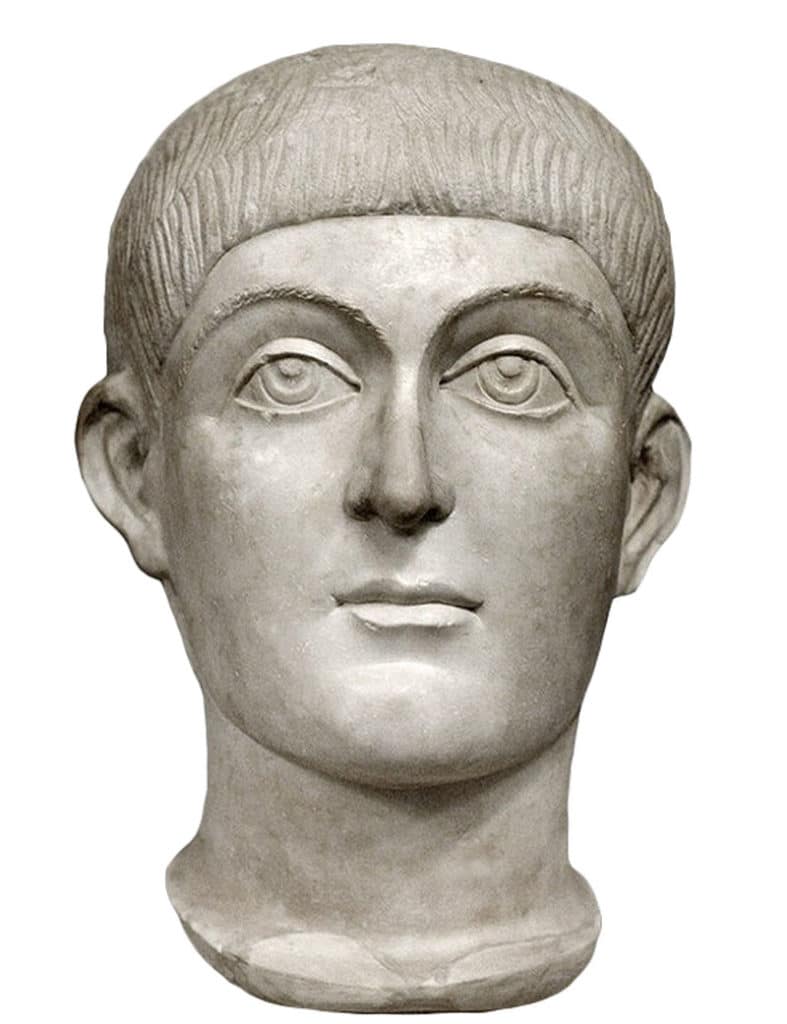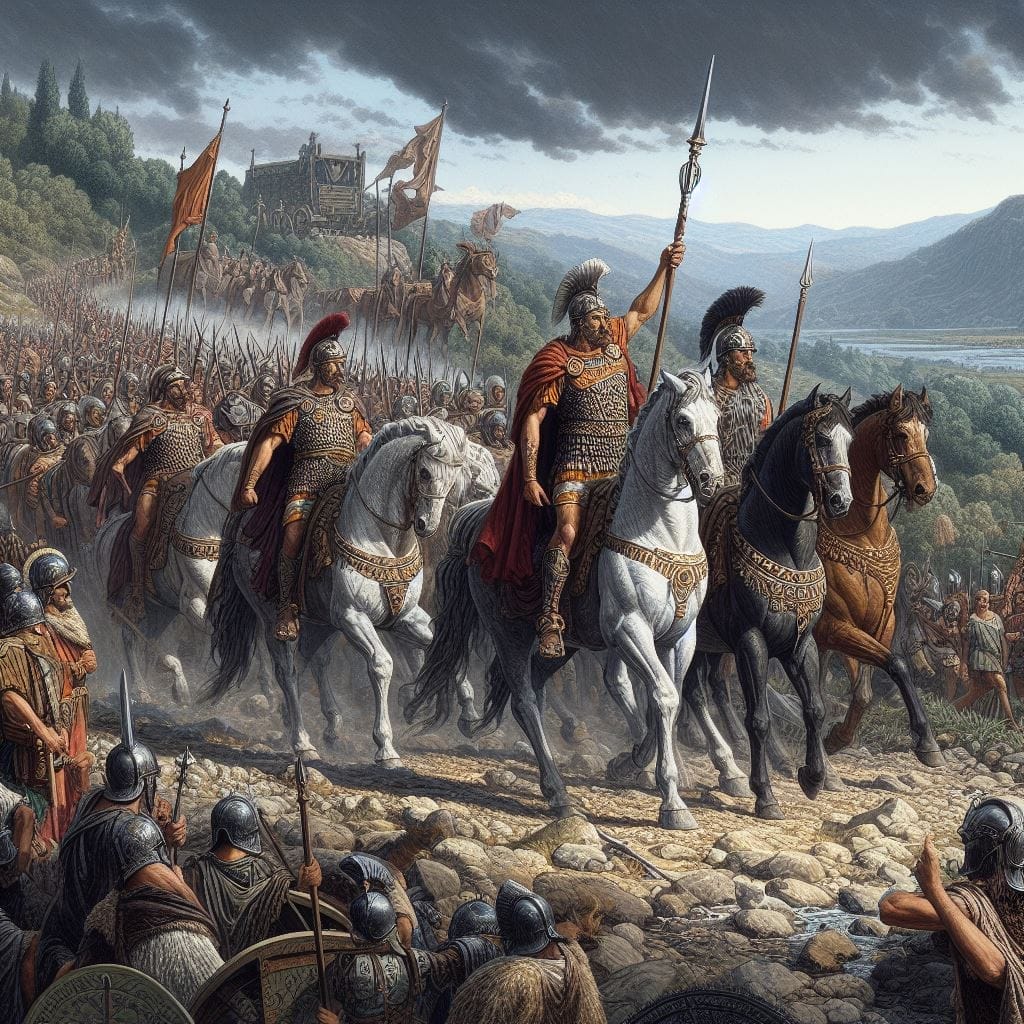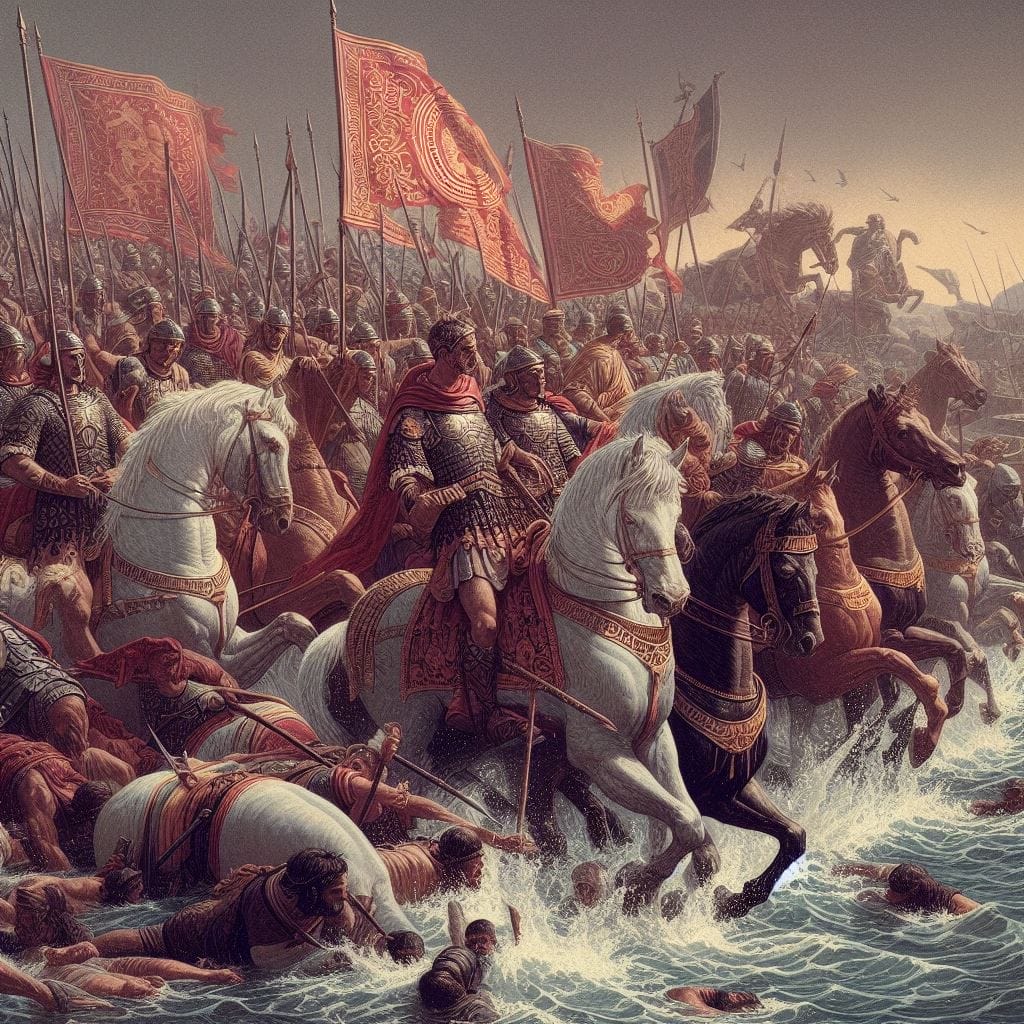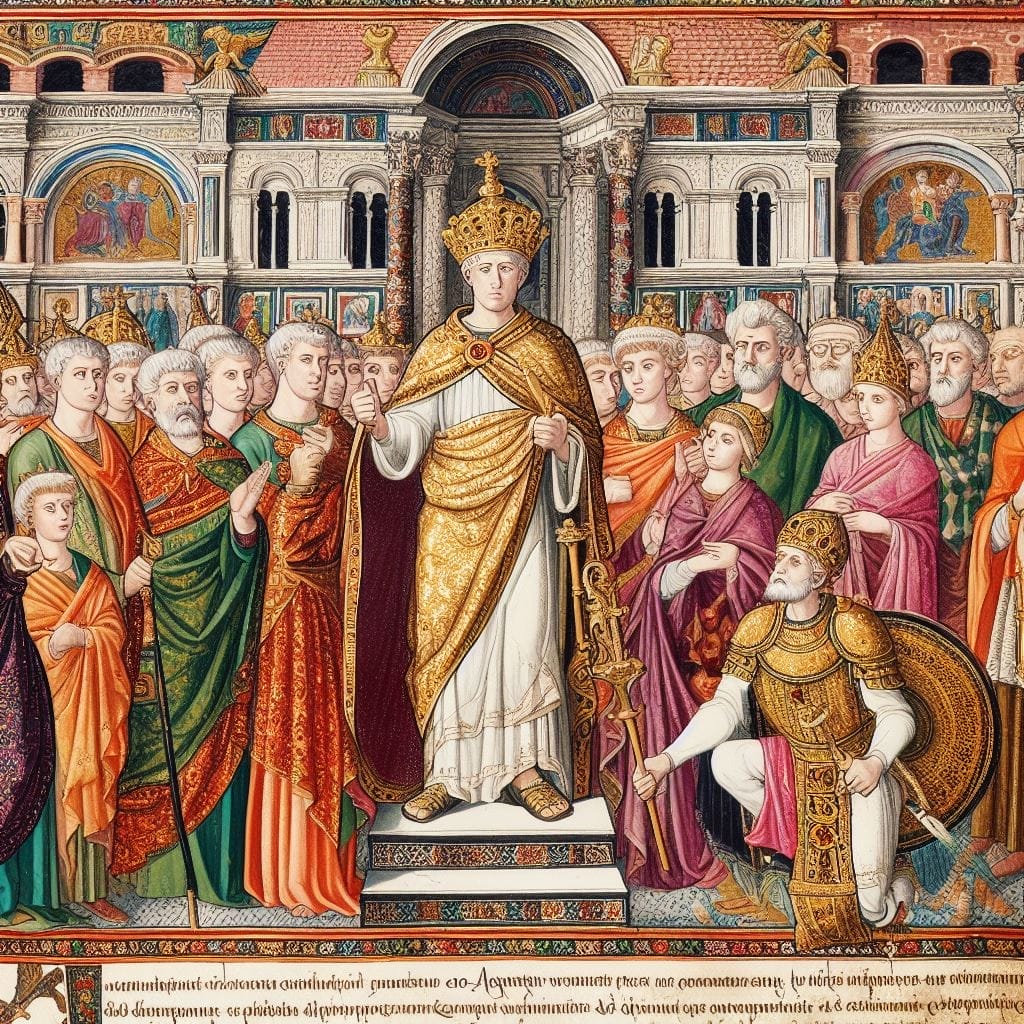Life: AD 383 – 423

- Name: Flavius Honorius
- Born in AD 383.
- Became emperor in January AD 395.
- Wife: Maria.
- Died at Ravenna, AD 423.
Early Life of Honorius
Honorius was the second son of Theodosius the Great and Aelia Flavia Flaccilla and was born in AD 383. In AD 393, he was raised to be co-Augustus at Constantinople. At Theodosius’ death in AD 395, Honorius assumed the role of emperor of the west, with his brother Arcadius becoming emperor of the east.
This division of the empire into eastern and western parts was the decisive one, which sent the two on separate ways. Had the empire effectively been split by Valentinian, it would have still functioned as a unit. One of the two emperors had always enjoyed seniority over the other. However, the accession of Arcadius and Honorius is widely seen as the division of the Roman empire into two completely separate parts. Arcadius is, therefore, often quoted as the first ‘Byzantine’ ruler.
At his accession, Honorius was only twelve years old, and Theodosius had appointed a guardian to watch over matters of state for him – the ‘Master of Soldiers’ Flavius Stilicho. Stilicho was half-Vandal, half-Roman, and married to the emperor’s cousin Serena. The daughter of this couple, Maria, was even married to the young Honorius in AD 395. Theodosius had chosen well in Stilicho, for he was a man of considerable ability.
However, Stilicho’s regency was marred by a bad relationship with Constantinople, which eventually degenerated into open hostility. For one, Stilicho made the claim that Theodosius had granted him guardianship over both emperors, which was a statement that may well have been true. But the power behind the throne in Constantinople was the praetorian prefect Flavius Rufinus, who had no intention of surrendering his power to the Vandal Stilicho. Furthermore, Stilicho chose to attempt to add the Balkan territories of the prefecture of Illyricum to the Western empire and at least enlarge Western power.
The Death of Rufinus
Blatantly pursuing this goal, he marched his troops into Greece at the outbreak of the Visigoth rebellion against Arcadius under the pretext of seeking to help the eastern empire. But when ordered out of the eastern territories by Rufinus in Constantinople, Stilicho backed down and withdrew, leaving behind a few legions under the command of his Gothic general Gainas, which were to be restored to the east.

As they marched to Constantinople, they stabbed Rufinus to death as he came to welcome them. Clearly, this assassination was the work of Stilicho, and it did irreparable damage to the relationship between the Eastern and the Western empires. But with the Visigoths still rampaging through the Balkans and Greece, Stilicho was in AD 397 formally asked by Constantinople, now governed by the eunuch Eutropius, to come and aid them against the barbarians.
As Stilicho moved to Greece, but Alaric and his Visigoths got away. Constantinople, forced to buy Alaric off by making him ‘Master of Soldiers’ in the Balkans, responded furiously by pronouncing Stilicho a public enemy. It had since been the cause of much speculation if Stilicho indeed did let his fellow German Alaric getaway or if indeed Alaric simply outwitted his foe. In the very same year, AD 397, an uprising in Africa took place, led by the military commander called Gildo.
Gildo revolted against the Western empire, of which his territory was a part, and declared for Arcadius instead. This, though, meant that the valuable African grain supply to Rome fell into the hands of the East. Stilicho, of course, suspected the doings of Eutropius in this, though he did not follow the manyfold advice of starting an open war with the East. Instead, he engaged in systematic diplomatic intrigue, which eventually, in AD 399, saw Eutropius discredited, thrown from office, and banished into exile.
Meanwhile, Stilicho crushed the rebellion of Gildo and returned Africa to the Western empire. The hostilities of the Visigoths in the Balkans eventually were deflected from Constantinople toward the west by Eudoxia, Arcadius’ wife and effective regent of the east.
The Invasion of Visigoths
In AD 403, Italy was terrified by an invasion of the Visigoths, smashing their way into the very homeland of the empire. But Stilicho, gathering troops from the Rhine, Britain, and from wherever else he could, managed to halt their advance and force them back out of Italy.
Meanwhile, Honorius decided to move his residence from Mediolanum (Milan) to the greater safety of Ravenna in AD 404. And Italy was indeed far from safe. In AD 405, the Ostrogoths, who had in previous years been gradually forcing their way across the Middle Danube, now under the leadership of Radagaisus, flooded over the Alps into Italy. But, once again, Stilicho saved the day by decisively defeating them at Faesulae (Fiesole).
Stilicho now made plans to attack the eastern empire. But he was forced to abandon them as in AD 406, huge numbers of Vandals, Suevi (Sueves), Alemanni, Alans, and Burgundians crossed the frozen Rhine. Moguntiacum (Mainz) and Treviri (Trier) fell to the invaders, who then spread out into Gaul in a wave of utter destruction.
As Stilicho struggled to stem the tide, the troops of Britain mutinied in AD 406, seeing a series of men pronounced emperor and killed until, eventually, Constantine III achieved rule over the island. Parts of Gaul and Spain soon joined him.
In such desperate times, Stilicho saw no other means to save the empire than to buy off Alaric and his Visigoths. The price demanded was four thousand pounds of gold. The senate was unwilling to yield such an obscene amount of money, but Stilicho forced them to comply.
But the pressure brought to bear on the senate should cost Stilicho dear. The senators resented his methods and conspired to rid themselves of him. Soon after, Stilicho was accused of plotting with Alaric to depose Honorius and instead make his own son, Eucherius, an Emperor of the West.
The Downfall of the Conspiracy Plot
The troops at Ticinum (Pavia) were persuaded to stage a mutiny against their leader, and in AD 408, Stilicho surrendered at Ravenna to the emperor and was executed. The effect of Stilicho’s downfall was disastrous. Stilicho’s many German soldiers thereafter all went over to Alaric in order to avoid persecution by the Romans. Alaric himself, no longer hoping for the bribes to keep the peace he’d received from Stilicho, now marched on Italy. Rome was only rescued by payment of another vast payment by a reluctant Honorius.
For a short period, Alaric and Honorius strangely co-existed in Italy. Occupying Portus Augusti, Alaric, in AD 409, even set up a puppet emperor of his own, the prefect Priscus Attalus, who was confirmed by the Roman senate, terrified at having the barbarians so close to their capital. But Attalus didn’t last for long, soon being deposed again in AD 410 by Alaric.
Alaric’s March on Rome
Then, in AD 410, Alaric’s camp was attacked by Sarus, another Visigoth leader. Did Alaric know Sarus as an enemy of his – he believed this attack to have been done on Honorius’ behalf. Alaric broke off all negotiations with Honorius and marched on Rome. Agents within the city opened the gates, and on 24 August AD 410, the Visigoths fell upon Rome and sacked the ancient city for three days.

Thereafter, Alaric, taking with him the emperor’s twenty-year-old half-sister Aelia Galla Placidia, moved on into the south of Italy. Apparently, he had plans to embark and conquer Africa. But before any of this plan could be put into action, Alaric died at Consentia (AD 410).
In AD 411, the able commander Constantius (who was to become Constantius III in AD 421) became Honorius’ leading military commander, in effect filling the vacancy left by Stilicho. While the Visigoths, now led by Alaric’s brother-in-law Athaulf, were still lingering in Italy, the empire of the breakaway emperor Constantine III was collapsing. It extended from Britain to northern Spain. It broke down, partly owing to the revolt of one of his officers in Spain, Gerontius, and partly because of the military talent of Constantius. Gerontius was besieging Constantine III at Arelate (Arles) when Constantius intervened decisively.
Jovinus, the Emperor of Gaul
Gerontius retreated to Spain, where he was murdered – Constantius captured Arelate and, with it, Constantine III, who was executed. Returning to Italy, Constantius effectively drove the Visigoths out into Gaul in AD 412. Meanwhile, though, a new usurper, Jovinus, was proclaimed emperor in Gaul. Yet another complication arose when, in early AD 413, Heraclianus, Count of Africa, proclaimed himself emperor, too. Worse still, Heraclianus, having already amassed a great fleet, sailed for Italy.
Though Heraclian’s rebellion proved an utter fiasco as he was captured and executed in midsummer. Meanwhile, it had not been possible for Constantius and Honorius to take direct action in Gaul. Instead, they had to bargain with Athaulf, who then crushed Jovinus. Also, the Burgundians, who were the allies of Jovinus, proved too powerful to deal with. And so they were granted the right to form their own kingdom within the empire and henceforth were considered federates (foederati) who would act as allies to the emperor.
All along, Aelia Galla Placidia, Honorius’ half-sister, had remained in the hands of the Visigoths ever since the sack of Rome. However, the princess had in Constantius a devoted admirer who wanted her back. Naturally, Emperor Honorius also understood it as a stain on his honor that his sister should be a hostage of the barbarians.
It was part of the bargain with Athaulf that Galla Placidia should be returned. But the Roman part of the bargain, the supply of corn to Athaulf’s troops, had been come to nothing due to the rebellion of Heraclian. Consequently, Athaulf, instead of returning the princess, married her himself in AD 414 at Narbo (Narbonne), apparently with her own willing consent – but without that of her brother.
The marriage failed to draw Athaulf any closer to the imperial court, as, in fact, he set up Priscus Attalus as his puppet emperor of the west in Gaul. This was a step too far for Constantius, who now marched into Gaul and forced Athaulf to withdraw into Spain. Meanwhile, Priscus Attalus was captured and taken back to Rome.
The Conquest of Spain
Once in Spain and left to his own devices, Athaulf set out to conquer Spain. But there he was murdered in AD 415, and his successor Wallia struck a bargain with Rome. Wallia agreed to hand Galla Placidia back to the Romans (where she reluctantly accepted the hand of Constantius) and to make war with the other barbarians in Spain.
Faced with the dual threat of Romans and Visigoths, the other barbarians in Spain (Vandals, Alans, and Sueves) hastened to seek peace with the empire, which they obtained. In exchange, the Visigoths were allowed to return to Gaul, setting up their capital in Tolosa (Toulouse). The agreement between Wallia and Honorius was similar to the treaty made by Theodosius with the Visigoths in the Balkans almost thirty years earlier (AD 382) or with the Burgundians more recently in the West.
Becoming co-Augustus
It defined the Visigoths as federates within the empire. They enjoyed self-rule over their territory in Aquitania, though they needed to provide troops to the empire. Having rescued the western empire from utter destruction, Constantius was rewarded by being made co-Augustus in AD 421, and his wife, Galla Placidia, was invested as Augusta.

However, the eastern emperor, Theodosius II, refused to accept either the elevation of Constantius III or of Placidia, which led to threats of war by Constantius III and a renewed deterioration of relations between East and West. But after a reign of only seven months, Constantius III died.
After his death, Honorius, who had always been very affectionate toward his (half-) sister, began making advances towards his Galla Placidia, caressing her and embracing her in public. Not merely did this cause public outrage, but it alienated her from him, and she fled to Constantinople in AD 423, taking the two sons of Constantius III with her.
In the same year, AD 423, Honorius fell ill and died.
People Also Ask:
What was Honorius known for?
Honorius, in full Flavius Honorius (born September 9, 384—died August 15, 423), Roman emperor in the West from 393 to 423, a period when much of the Western Empire was overrun by invading tribes, and Rome was captured and plundered by the Visigoths.
Which Roman emperor was controlled by a chicken?
Perhaps, in his own peculiar way, Honorius sought to demonstrate control over his crumbling empire through his dominance over Rome, the chicken. Others suggest that it may have been an attempt to garner divine favor, as chickens were often associated with augury in ancient Roman religious practices.
How long was Honorius emperor?
Honorius (Flavius Honorius Augustus; 9 September 384 – 15 August 423 CE) was the Western Roman Emperor from 393 to 423 (age 9-39). He was the younger son of emperor Theodosius I and his first wife Aelia Flaccilla and brother of Arcadius (b. 377), who was the Eastern Emperor from 395 until his death in 408 (age 18-31).
Who ruled after Honorius?
Honorius died of edema on 15 August 423, leaving no heir. In the subsequent interregnum, Joannes was nominated Emperor. The following year, however, the Eastern Emperor Theodosius II installed his cousin Valentinian III, son of Galla Placidia and Constantius III, as Emperor.

Historian Franco Cavazzi dedicated hundreds of hours of his life to creating this website, roman-empire.net as a trove of educational material on this fascinating period of history. His work has been cited in a number of textbooks on the Roman Empire and mentioned on numerous publications such as the New York Times, PBS, The Guardian, and many more.
